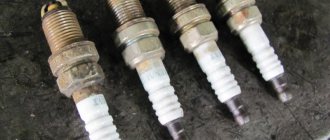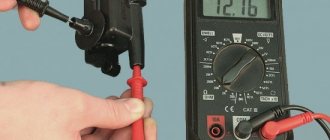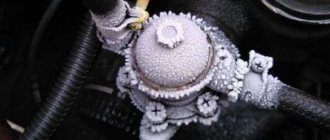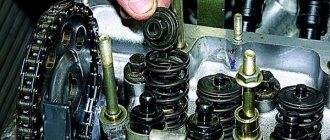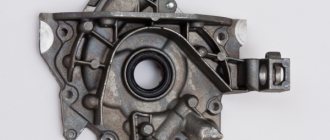Purpose, principle of operation
So, glow plugs are designed to heat diesel fuel sprayed into the combustion chamber to the evaporation temperature, after which it mixes with air and ignites. This is only necessary at the very beginning of the movement (start and another 2-3 minutes), then the car warms up and the spark plugs turn off, because there is no longer any need for them.
The candle is placed in such a way as to fall into the flow of sprayed diesel fuel. The working part (a heating coil with or without a casing) protrudes into the combustion chamber and not only heats the incoming fuel to the desired temperature, but also creates additional turbulence in the vapor, which means it helps its distribution and combustion more evenly.
In most cars, glow plugs are turned on at any time of the year, and even in summer they make engine starting easier. In the newest models, the automatic system detects the engine temperature, and if it is already warmed up (coolant temperature 60°C or more), the spark plugs do not turn on.
How to check a glow plug on a diesel engine:
principle of operation of glow plugs in a diesel engine, winter additives for diesel fuel
Winter for a diesel engine comes after +5 oC and starting the engine with non-working spark plugs is only possible up to this temperature.
The principle of operation of glow plugs in a diesel engine is to ensure the required auto-ignition temperature and normal fuel mixture formation in the combustion chamber.
The operation of the spark plugs is notified by an indicator located on the instrument panel, indicating that the air in the combustion chamber is ready to receive a portion of diesel fuel.
Experience shows that you should not trust these indicators. Because, as practice shows, it lights up even if the relay of the spark plug control unit does not operate and the fuse blows. How often do you change spark plugs in a diesel engine?
The frequency of replacing spark plugs in a diesel engine is about 5-6 years. It all depends on whether the internal glow coil in the spark plug has burned out or not.
How to check a glow plug in a diesel engine: Turn the plug out of the head, drop the “+” “-” onto the housing. If the spark plug is working properly, the glow tube will immediately begin to heat up. And after 10 seconds , it will become hot and begin to glow; if this does not happen, the candle should be replaced.
Design
Basic design of a glow plug
Modern glow plugs are designed with one or two internal coils. The heating coil is made of metal with specified resistance values and heats up depending on the current strength. The second spiral - the adjusting one - performs the function of automatically adjusting the current strength: the higher the temperature of the spiral, the higher the resistance value and the less current it passes to the heating coil. That is, with an increase in the temperature of the working part, the heating of the candle is automatically adjusted.
When the ignition is turned on, current is supplied to the terminal and from it to the central electrode. Next, the voltage is supplied to the adjusting and heating coils. The latter heats up, heating the tip of the candle to 1000°C in a few seconds. 3 minutes after starting the engine, the relay turns off the current supply to the spark plugs, and the engine runs as normal.
When the engine starts, the spark plug icon lights up on the instrument panel. While it is burning, the candle is warming up; when it goes out, you can go.
The shape and size of the spark plug depend on the engine model: in older cars with two-valve cylinders, there is enough space for the spark plug, which means it can be quite short and thick. Modern common rail engines with a four-valve design require different design solutions: the spark plug must be long and thin to take up less space.
Options for placing spark plugs in a diesel engine
Manufacturers offer the latest models of glow plugs with a working part diameter of only 3 mm. But along with the change in the shape of the candle, its strength also changes: long candles require extremely careful handling when removing and installing, since they break very easily.
Types of glow plugs and their design
A glow plug is similar in appearance to a spark plug, but it does not produce a spark. The candle has a heating element in the shape of a spiral, which can be made of metal or ceramic.
Glow plugs can reach temperatures of 1,350 degrees Celsius in a matter of seconds
The metal heating tip of the candle consists of two spirals: heating and adjusting. The first is needed to quickly heat the tip, and the second protects the spark plug from excessive overheating. This occurs due to the increase in electrical resistance of the adjusting spiral with increasing temperature.
The space between the heating tube and the coils is filled with an insulating filler, which performs two functions – protecting the coil from mechanical stress and efficient heat transfer. Glow plugs with a metal spiral can heat up to 1,000°C.
A glow plug with a ceramic heating element is similar in principle of operation. Its design difference is that the heating element - a spiral - is located in a ceramic shell. Thanks to this, such a candle heats up faster. Its power is also higher - 1,350°C. This candle heats up in just a few seconds.
Technical characteristics, design features
Glow plugs are constantly being improved: manufacturers are introducing new materials to reduce heating time and extend service life. As a result, from a fairly simple part with an open spiral, candles have turned into high-tech devices that meet the highest modern standards.
- Open and closed
Glow plugs were originally designed with an open coil, and such designs can still be found on some older vehicles. All modern candles are made closed: the spiral (one or two) is closed with a protective cap that protects them from burning out too quickly. Between the spiral and the body there is a heat-conducting powder, which allows heat to be transferred from the hot spiral to the tip in a short time.
Glow plug of open (a) and closed (b) type
- Number of poles
The candle can have one or two connection poles.
With a single-pole connection, the “plus” is supplied to the spark plug, and the “ground” is output to the housing.
Bipolar spark plugs have separate contacts at the top for “plus” and “minus”.
- Performance
Older spark plug models heat up to operating temperatures in 25-60 seconds. Modern fast-acting candles heat up in 10 seconds, and self-regulating ones - in 2-5 seconds. Achieving such a heating rate was made possible by the use of a regulating spiral, thanks to which the issue of burning out the heating element is eliminated, which means that more current can be used for instant heating.
- Material of manufacture
Glow plugs differ in the material used to make the working part.
Pin spark plugs have a metal shell made of a resistant alloy of iron, chromium and nickel. The heating coil is insulated from the body with heat-conducting powder (magnesium oxide), which, in addition to its insulating properties, also protects the coil from vibrations.
In ceramic candles, the heater is made of a refractory ceramic alloy that can withstand heating to maximum temperatures for a long time. The protective shell is made of silicon nitrite, a ceramic material with the highest thermal conductivity. Thanks to the design, the ceramic spark plug heats up to operating temperatures in a record time of 2 seconds, which allows you to start the engine immediately without waiting for warm-up time.
To comply with Euro-5 and Euro-6 standards, only ceramic spark plugs are suitable, which ensure optimal fuel combustion from the first second of start-up.
- Voltage consumption
Different manufacturers produce glow plugs designed for certain parameters of the vehicle's electrical system. As a result, the rated voltage may differ: from 6 to 24 V. Spark plugs with an afterglow function are installed complete with additional resistance: before starting the engine, heating occurs at maximum power, after starting the engine, the power is reduced to reduce the load on the adjusting spiral.
- Resistance
The resistance of the heating coil is 0.5-1.8 Ohm, depending on the type of candle (ceramic ones have less resistance, metal ones have more).
- Temperature and heating rate
The heating temperature of the working part is 1000-1350°C. For ceramic candles, this figure will always be higher, since the material of the heating coil suffers less from overheating.
The heating rate depends on the type of spark plug and the starting system.
Auto Glow and Self-Regulating Glow system - one relay that regulates pre-heating and warm-up after engine start depending on the coolant temperature. The candle heating speed is from 4 (metal) to 11 seconds (ceramic candles).
Super Quick Giow system - two relays, one for quickly heating the spark plugs before starting the engine (2-5 seconds, you can start the engine almost immediately), the second for constantly heating the spark plugs after starting.
Resource and replacement
Glow plugs, unlike spark plugs for gasoline engines, do not have a clear replacement schedule. They are changed as they fail, on average once every 1-2 years. It is better to check and replace spark plugs in the fall, so as not to get an unpleasant surprise in the first frost.
The breakdown of one spark plug will have virtually no effect on the operation of the engine: it will start with the remaining three, and it will even start more or less normally with two non-working spark plugs, but only in the warm season.
The service life of the simplest spark plugs with a metal spiral is 50-80 thousand km, ceramic ones will last much longer - up to 160 thousand km, and some models of Japanese-made spark plugs - up to 240 thousand km.
Even if the check reveals that only one spark plug has failed, it is better to replace the entire set so that the service life of all spark plugs is exhausted evenly.
Checking the condition of the glow plugs
The condition of the glow plugs must be carefully monitored and changed in a timely manner, especially if the car is operated in winter (how often the car manufacturer will indicate how often to change). Firstly, before winter you need to check their performance, since even one non-working spark plug will not allow you to start the engine at sub-zero temperatures. If the check reveals one, then it is better to change the entire set, since the rest may soon fail.
There are two safe ways to check spark plugs. The first requires the participation of two people. You will need to unscrew the nozzles, after which one person will look into the wells, and the second will turn the key to the pre-start position. Working spark plugs will turn red from heating. However, this method is not suitable for everyone, because... On some engines, spark plugs are simply not visible through the injector wells.
The second way to check the serviceability of the spark plugs is with a multimeter. You need to select the circuit check mode, then touch the spark plug body with one probe and its cap with the other. If the circuit is closed, then it works, otherwise it needs to be changed.
On many modern cars, checking glow plugs is performed in self-diagnosis mode, and the electrical wiring diagram is supplemented by an indicator on the dashboard, signaling a breakdown.
Under normal operating conditions, glow plugs need to be changed on average once every 60 thousand km. If the machine is constantly operated under extreme conditions, then it would be a good idea to check their performance at least once a season, and change them either at frequent intervals or when they fail.
Possible problems when replacing glow plugs
The origins of the problem lie in the geometry of the spark plug itself: a long and thin rod is easy to break, especially considering the tight fit of the spark plug in the spark plug well, where the gap between it and the spark plug is filled with combustion products and oxides. Masters call this situation “the candle is stuck.” Unscrewing a stuck spark plug is a task for an experienced technician, and even then there is a risk of breaking the spark plug if too much force is applied.
Unlike spark plugs, it is best to entrust the replacement to a good service station: in addition to tools and special materials (penetrating lubricant, for example), experience in such work is required. For comparison: replacing glow plugs will cost about 400 hryvnia, drilling out a broken spark plug will cost from 1500 and above (to infinity), depending on the complexity of the work.
Spark plug damage due to improper installation
When replacing spark plugs yourself, you need to consider several points:
- Replacing spark plugs must be carried out only on a warm engine and in a warm room (or during the warm season) so that the engine does not have time to cool down during operation. Accordingly, you only need to work with gloves to avoid burns.
- You need to unscrew a used spark plug just as carefully as screwing in a new one, taking your time and observing the torque. To facilitate the process, a special penetrating lubricant or synthetic motor oil is used.
- When unscrewing the spark plugs, try unscrewing each one one at a time. After all the attempts, increase the force on the key and try again to unscrew all the spark plugs one by one.
- Before installing new spark plugs, their seats are cleaned of carbon deposits.
- When installing, the spark plugs are not screwed in all the way! The tightening torque recommended by the manufacturer must be strictly observed.
INDEPENDENT CHECKING AND REPLACING GLOW PLUGS
PREPARATION
Before replacing or repairing anything, you need to check the serviceability of the part. In order to carry out initial diagnostics and replace glow plugs on a diesel engine, you will need the following devices:
Also, to successfully replace glow plugs in your car, it doesn’t hurt to have manuals with images of the devices you will have to deal with.
Modern spark plugs installed on most cars are quite fragile products.
Therefore, they must be handled with extreme caution. One wrong move is enough to break them
Unfortunately, despite all the care, spark plugs often break when replaced. In most cases, this happens inside the nest. Therefore, you need to make sure in advance that you have a drill or a drill at hand
With their help, you can remove the remaining rod from the hole.
STEP-BY-STEP INSTRUCTIONS FOR REPLACING GLOW PLUGS
To replace spark plugs on your car, simply follow the algorithm below.
Allow the engine to cool. Otherwise, you risk getting burned. Open the hood and remove the cover. Disconnect the wire connected to the negative terminal. Remove the intake manifold. Visually inspect the engine. Find the place where the glow plugs are installed. Concentrate on the injectors. Usually the elements you need and want to replace are located there. Unscrew the fixing nuts. Remove the cable ends. Clean the prechamber holes. Clean the spark plug channels (this must be done using a reamer). Subsequently, lubricant is applied to the grooves. Ideally, a device that supplies a stream of compressed air is best suited for removing carbon deposits. Glow plugs are replaced using a special key
With its help, you need to unscrew the elements, while being extremely careful. Candles break very easily at the base.
After the glow plugs are removed, immediately before their possible replacement, it is necessary to carry out an inspection and check
In this case, you need to use the device. Most automotive experts agree that even if you find just one faulty spark plug, it is better to replace the entire set.
Use a torque wrench to replace parts. Put on the tips from the spark plug wires and tighten the nuts. Don't forget to check the fit and make sure the contacts are completely closed. Connect the negative cable to the battery.
At the end of the replacement procedure, you will need to reinstall the intake manifold. To check the newly installed parts, simply start the engine. If the motor runs stably, then everything is in order.
Attention! Only after you have checked the functionality of the new parts can you install the protective casing in place. Replacing incandescent elements is within the power of every driver
All you need to do is prepare a set of tools and follow the instructions. For an experienced driver, the whole process can take no more than 20-40 minutes
Replacing incandescent elements is within the power of every driver. All you need to do is prepare a set of tools and follow the instructions. For an experienced driver, the whole process can take no more than 20-40 minutes.
Replacing glow plugs on a diesel engine is a standard procedure, thanks to which the car is successfully started in the cold season, and also increases the long-term life of the device. This article will discuss how the replacement process is performed, the principle of operation, etc.
What shortens the life of spark plugs?
Since there are no replacement regulations for glow plugs, their service life will largely depend on operating conditions. What shortens the “life” of candles:
- Incorrect installation. You need to be able to install a glow plug normally, and the slightest failure to comply with the technology (for example, working on a cold engine or incorrectly applying force to the key) can damage the spark plug even at the installation stage.
- Faulty or clogged fuel injector. Under normal conditions, the fuel is sprayed into a fine mist, with only a portion of it making contact with the spark plug tip. If the injector holes are clogged, diesel fuel will spray out, often directly onto the spark plug. Because of this, the tip quickly burns out and the spark plug fails.
- Installing an unsuitable spark plug (not designed for this type of engine or on-board voltage).
- Malfunction of adjacent components of the car, for example, engine oil getting on the spark plug due to engine wear, malfunction of the injection control system, malfunction of the computer.
- Carbon deposits around the spark plug can create a short to ground, which quickly damages the spark plug. To avoid short-circuiting on new spark plugs, before installing them, technicians clean the spark plug socket from carbon deposits using a special reamer.
When replacing spark plugs, you need to pay attention to the condition of the used ones: their condition may indicate problems in the engine operating system:
- A swollen tip usually indicates overheating due to excessive tension on the heating coil or engine oil getting on the spark plug.
- A damaged or broken tip indicates a malfunction of the fuel injection system (clogged injectors or poor synchronization of the system).
- Damage to the contact rod (at the top) and movement of the tip relative to the body indicate incorrect installation (tightening too tightly).
Glow plug in a diesel engine of a modern car
Spark plugs in a diesel engine ensure a guaranteed start of the power unit when cold. The principle of their operation is to bring fuel under high pressure to the required temperature using a special relay.
A diesel engine has as many spark plugs as there are cylinders in it. There is one spark plug for each engine cylinder.
The principle of switching on a diesel engine
The fuel-air mixture, which is under pressure in the cylinder, is heated to 900°C. To ensure fire conditions, the design is highly durable. The combustible mixture is ignited by the compression ratio, and not by the spark plug.
At air temperatures below plus 5°C until severe frosts, the combustion chamber lacks forced heating using ceramic or pin glow plugs.
The glow plug in a diesel engine is capable of heating the injection area to 1000°C in a matter of seconds. When the diesel engine is turned on, these devices work until the cooling liquid temperature reaches plus 75°C.
Due to the increased demands of environmentalists, thanks to their unique features, spark plugs begin to function at idle speed. The design of these parts helps reduce the amount of harmful diesel engine emissions into the air.
Design features of different types of candles
These structures can be made of either closed ceramics or open metal. The heating element is made in the form of a spiral.
Iron pin structures have spirals: heating and adjustment. Thanks to the first, rapid heating occurs, the second helps to protect the structure from overheating.
The composition of ceramic parts is more complex:
- Metal body.
- Heating tube.
- Connecting bolt and nut.
- Adjustment spiral.
- Ceramic filling.
- Central electrode.
- Threaded part.
Ceramic parts are more preferred due to their ability to quickly create heat and provide a very high temperature.
Under the influence of electric current, the coil heats up. The high temperature in the motor does not allow the element to heat above 850°C; heating continues for a short time: from 4 seconds to 2 minutes.
The duration of heating is monitored by an electronic control unit, which monitors the temperature of the coolant through special sensors.
As long as the heating continues, the control light located on the instrument panel lights up. Turning off the lamp indicates that the engine is completely ready to start.
Glow plugs also work after the engine is turned on, continuing to warm up and ensuring the most complete combustion of the air-fuel mixture, reducing harmful emissions.
Methods for checking spark plugs
You can check the voltage in the elements using a multimeter or car battery.
In order not to dismantle the device, just connect it to the battery. The connection diagram is as follows: the minus is connected to the spark plug body, and the plus to the terminal, respectively.
In a working unit, the coil heats up within a few seconds. The absence of heat indicates the need to replace the device.
When checking the spark plugs in the injectors, it is necessary to unscrew the elements and examine the glow of the pins, which should glow. The difference in the intensity of the glow despite the fact that one element indicates the need for additional verification by measuring its resistance. To avoid rapid failure of the remaining elements, the entire set is replaced immediately, regardless of how many parts turned out to be defective.
It rarely happens that more than two devices fail, in which case it is necessary to diagnose the electrical wiring or electronic control unit.
Using a multimeter, the performance of a dismantled spark plug is determined by the “diagnosis” method.
In modern machines, it is possible to check these components using a guided method, additionally using an indicator located on the device panel, which gives a signal when a spark plug breaks.
Description of fault indicators of incandescent elements
Failures of glow plugs are manifested by the following disadvantages:
- The engine does not want to start.
- Uneven operation of a cold engine.
- The appearance of white exhaust gases.
If the car owner relatively recently replaced all the spark plugs, then the circumstance may lie in a malfunction of the element due to the fault of the manufacturer. The defective part must be unscrewed and replaced with a new copy. Malfunctions of incandescent elements are most noticeable in winter.
A decrease in temperature in the environment leads to the appearance of more indicators of malfunctions of filament elements.
In order to reduce the dismantling process, a special diesel engine glow plug puller is used. It must be used in a set with a tool adapted for a square or hexagonal head.
What causes spark plugs to fail?
The service life of modern pin glow plugs for diesel engines is 60 thousand kilometers, provided that operating conditions are met. If damage to the shell of the spiral occurs, the entire device will fail earlier, because moisture and dirt get inside the crack that appears, and the spiral closes to the body. The shell may fail due to the following circumstances:
- accuracy and lack of care when installing the glow element in the engine;
- the appearance of electrochemical corrosion over time;
- installation of spark plugs that do not correspond to the models of this type of diesel engine.
These devices are extremely important - they ensure uninterrupted starting of a diesel engine at sub-zero air temperatures and significantly reduce the amount of exhaust harmful gases.
Why are glow plugs used in diesel engines?
Similar articles selected for you:
- Repair of diesel engine turbines. causes of malfunctions
- Consequences of diesel engine overheating
- Additives for diesel engines: both in the tank and in the engine
- Diesel engine power system
Checking the glow plugs
The main damage to the candle itself is damage to the heating coil. You can check the performance of the spark plugs yourself, without even removing them from the engine. To do this, you will need a tester that will measure the resistance of the spiral.
You must first disconnect the battery from the on-board power supply. Then set the tester to ohmmeter mode, touch the spark plug terminal with the positive contact, and touch the vehicle ground with the negative contact. The resistance indicator on a working spark plug is very small, and the tester does not always detect it. But resistance close to infinity indicates a broken spark plug (no contact).
Tester connection diagram: 1, 2 – for a single-pole spark plug, 3 – for a double-pole spark plug.
If an almost new spark plug fails, this indicates a malfunction in the fuel system or electronic control and requires professional diagnostics.
Methods for checking glow plugs for diesel engines
The failure of one or two glow plugs may not be noticeable in relatively warm weather. And when frost sets in, difficulties immediately arise in starting the diesel engine.
We will describe three different ways to test the performance of glow plugs. The choice of each of them depends on whether the motorist has certain devices, tools, skills and free time.
Method 1 - Checking glow plugs using a battery
The most accurate and clear picture of the serviceability of heating elements for a diesel engine is given by checking the battery. Each spark plug is checked separately, and the car enthusiast sees the degree of its glow.
The disadvantage of this diagnostic method is the need to unscrew all the glow plugs. This will require a significant amount of time in some cars, as well as the dismantling of some parts that make access to the heating elements difficult.
- To carry out the tests, you will need an insulated wire about 0.5 m long.
- The glow plug is turned upside down by the heating element and installed with the central electrode on the positive terminal of the battery.
- Using an electric wire, you need to connect the negative terminal of the battery and the spark plug body (in the side part).
- If the heating element quickly heats up by more than half, then the spark plug is working.
- If there is no glow or only the tip of the element is heated, the spark plug needs to be replaced.
Below are easier ways to check glow plugs.
Method 2 – Checking the glow plugs with a multimeter
Sometimes there is no time or tools to remove the glow plugs from the head of a diesel engine. In this case, checking with a multimeter may be useful. The device is installed in the position for testing resistance (ohmmeter).
But first you need to disconnect the wire from the glow plugs that supplies current to the central electrode. Each heating element can be supplied with a separate wire, or all candles can be connected by a copper or brass busbar. Now all that remains is to connect the positive probe of the multimeter to the central electrode of the spark plug, and touch the negative probe to the side surface of the housing. If the arrow does not deviate or there is no reading on the digital display, then there is a breakdown in the heating element. The glow plug needs to be replaced.
The disadvantage of this method is the difficulty of identifying heating elements with low heat. The tester will show that there is no breakdown, and the spark plug will not warm up the combustion chamber sufficiently.
Method 3 – Checking the glow plugs for a “spark”
An old, tried-and-true way to check the health of glow plugs is the degree of sparking. To do this, you will need an insulated wire 0.5-1 m long, at both ends of which 1-2 cm of insulation is removed.
Now you need to free the glow plugs from the tire and supply wire. One end of the test wire is attached to the positive terminal of the battery, and the other end makes a tangential movement along the central electrode of the glow plug ( see video below ). Thus we will be able to observe something like the following:
- A strong spark forms on a working heating element.
- If the spark plug is weakly heated, sparking will be insignificant.
- A completely faulty glow plug will have no spark at all.
This check can be safely done on old cars that do not have “brains” and a computer. In the video below, glow plugs are checked in this way on a diesel Nissan Primera.
The above methods for checking glow plugs allow you to independently discover the cause of poor starting of a diesel engine. If a faulty part is identified, the car owner will only have to replace the failed heating element. After this, starting the engine in the cold is usually not difficult.
Also, in the winter season, owners of cars with diesel engines will benefit from an engine pre-heater.
Additional "chips"
To improve the functionality of candles, manufacturers are constantly improving them: even small “pluses” can significantly improve operation.
A pressure sensor in the combustion chamber is an additional functionality that reduces NOx emissions. The sensor transmits information about the pressure in the combustion chamber to the ECU, which, in turn, adjusts the fuel supply.
One of the “weak points” is the heater rod, which breaks if installed incorrectly (at the wrong angle). Leading manufacturers produce spark plugs with a flexible axial shaft that can bend rather than break. The second solution to the same problem is a movably fixed central rod that compensates for excess pressure when tightening the spark plug.
The spark plug body is coated with zinc, which has anti-corrosion properties. This makes it easier to replace and extends its service life.
Self-check of diesel engine glow plugs
As already mentioned, glow plugs ensure reliable starting of a diesel engine, which is especially necessary in cold weather. Conventionally, such a solution can be considered a kind of heater. On different models of diesel cars, such solutions may differ in the operating algorithm and general implementation scheme. One thing they have in common is the presence of a glow plug screwed into the block.
We also recommend reading the article about what types of diesel fuel pre-heaters there are. From this article you will learn about the design features, installation locations, as well as the advantages and disadvantages of devices of this type for heating diesel fuel.
Early developments involve constant switching on of the glow plugs on a diesel engine in parallel with the ignition being turned on, that is, every time you try to start a diesel engine, the glow plugs heat up regardless of the current temperature of the internal combustion engine. As for more “fresh” diesel engines, the glow may not be activated by the system if the engine is already warmed up or the ambient temperature is positive.
These features must be taken into account separately before checking the glow plugs. It will be necessary to separately find out under what conditions the elements for heating the combustion chamber are used on a specific diesel engine model. The inclusion of glow plugs is accompanied by the lighting of a separate indicator lamp, which displays a spiral pictogram on the dashboard inside the car. At the end of this solution for warming up the chamber on a diesel engine, the indicated light goes out.
It should be added that in the event of a malfunction of one or even a pair of glow plugs, the engine can start normally provided the temperatures outside are above zero. In other words, the warrior simply does not notice the malfunction. In winter, the situation changes, since starting a diesel engine with faulty glow plugs in cold weather becomes very difficult or even impossible.
In such situations, when the diesel engine does not start, the first thing you need to do is check the quality of the heating and combustion gauges. Glow plugs can be checked in the following ways:
- connect glow plugs directly to the battery;
- evaluate the quality of spark formation on glow plugs;
- check the glow plugs with a multimeter tester;
Checking glow plugs directly from the battery
To check the glow plugs by connecting them to the battery, they should be unscrewed from the engine. Note that for accurate diagnostics it becomes necessary to unscrew all installed elements. Also, in some cases, it will be necessary to dismantle certain components on the engine itself that do not allow easy access to the spark plugs. These nuances are a significant drawback of this verification method. Additionally, you will need a special tool, certain skills and free time.
Currently reading
Internet in cars and more: features of technology...
Coating a car with ceramics: what you need to know
Remember, you need to be very careful when unscrewing and tightening the glow plugs, as there is a risk of breaking off the glow plug. If the glow plug has broken off, then more serious repairs will be required to remove the remainder from the diesel engine block head.
The advantages of testing from a battery include the accuracy that this method provides. The condition and performance of the heating element are assessed separately and visually. This eliminates the possibility of installing parts that work but do not provide the proper degree of incandescence.
To diagnose the glow plug from the battery, you should take a wire with insulation about 50-60 cm long. Then the glow plug removed from the engine must be turned over so that the part on which heating occurs looks up. Afterwards, the glow plug is powered by the central electrode on the “plus” of the battery. Next, a piece of pre-prepared negative wire connects the battery to the side of the spark plug housing. The next step is to check the heating rate and its efficiency. Fast and full heating of the heating element is a sign of performance. Slow heating and/or partial heating of only the tip indicates the need for replacement.
Diagnosis of a glow plug based on the intensity of spark formation
Another way to check glow plugs on a diesel engine is to evaluate the intensity of spark formation after power is supplied from the battery. For such a test, an insulated wire is required (similar to the feather method). Then at the ends it is necessary to remove the insulator so as to expose 100-150 mm. wires.
Next, the power wires are removed from the glow plugs, after which the wire, stripped at the ends, is attached with one side to the positive terminal of the battery for testing. The other end must be passed over the central electrode of the element being tested to heat it up. Next you should pay attention to the following signs:
- if the part is faulty, then there will be no sparking;
- partial performance and low heat appear in the form of a weak spark;
- on a fully operational element, the spark is strong, the sparking process is quite intense;
Checking the resistance of glow plugs with a multimeter tester
You can also check the glow plugs with a multimeter. This method requires less time and is the simplest. For diagnostics, you do not need to unscrew the glow plugs from the head. It is enough to disconnect the power wire from the central electrode of the spark plug being tested. Let us add that, structurally, the glow elements on a diesel engine can either have separate wires for each spark plug or be connected by one circuit.
It should also be noted that it will not be possible to simultaneously check the heating efficiency with a tester, which is considered a definite disadvantage. The fact is that a multimeter can show the serviceability of the element, but the combustion chamber will still be poorly heated.
To check glow plugs with a multimeter, switch the device to the “ohmmeter” operating mode. This is necessary to measure the resistance of the filament elements. To do this, the “+” tester probe is applied to the central electrode of the spark plug, and the negative terminal touches the side of the housing. The absence of readings on the device will indicate that the glow plug is faulty and requires replacement.
Standardization
Modern glow plugs are standardized according to ISO, which allows you to select plugs according to strictly defined technical parameters:
- Diameter and pitch of fastening thread: from M10x1.0 to M18x1.5.
- Wrench size: 12, 14, 17, 21 mm.
- Cone slope: 63, 93, 123°.
- Total length: 58-137 mm.
- Working part length: 17.35 mm.
- Working part diameter: 4-6 mm.
Glow plugs do not require special attention and frequent replacement. The only condition is a competent choice and installation, after which this issue will be closed for a long time.

